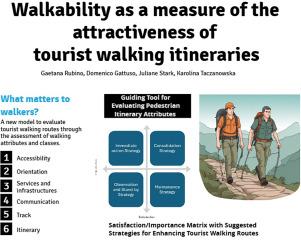可步行性是衡量游客步行路线吸引力的一个指标
IF 6.3
2区 工程技术
Q1 ECONOMICS
引用次数: 0
摘要
与传统的交通方式相比,主动交通一直被忽视。然而,研究和机构现在都认识到它对于平衡和可持续的运输系统的重要性,这对人类和环境健康至关重要。主动移动经常出现在日常移动的背景下,但它在休闲移动中越来越重要,特别是在旅游业中。学术研究主要集中在城市路径或乡村徒步旅行路线上,而忽视了混合城乡环境的旅游路线,如圣地亚哥之路(Camino de Santiago)或弗朗西吉纳大道(Via Francigena)。本文提出将可步行性概念扩展到农村环境,特别是与步行旅游流动性的基础设施(步行旅游)有关。这项研究基于全面的现场分析,卡拉布里亚步行路线组织者的焦点小组,以及来自国内和国际背景的用户调查,在可持续旅游的主动移动背景下进行。关键方面,如行程质量、周围环境和可用的基础设施,与社会人口特征和旅行习惯一起进行检查,以揭示这些属性对行人及其满意度的不同重要性。本文提出了一种评估线路吸引力的方法,强调了步行者优先考虑的转变,景观质量等因素的重要性超过了支持服务等传统的重要方面。这项研究在卡拉布里亚的路径和道路网络上测试了这种方法,根据它们的吸引力对它们进行排名。此外,本文还提出了一个将步行属性与满意度相关联的战略干预框架,以指导有效的行程规划和推广,从而实现可持续的旅游流动性。卡拉布里亚地区行程的案例研究突出了如何将该方法扩展到其他类似的行程。此外,该研究为后续的步行路线模拟奠定了基础,进一步支持未来徒步旅游和可持续交通的发展。本文章由计算机程序翻译,如有差异,请以英文原文为准。

Walkability as a measure of the attractiveness of tourist walking itineraries
Active mobility has long been overlooked compared to conventional means of transportation. However, both research and institutions now recognize its importance for a balanced and sustainable transportation system, crucial for human and environmental health. Active mobility is often seen in the context of everyday mobility, but it is increasingly significant for leisure mobility, particularly in tourism. Academic research has primarily focused on urban paths or rural hiking trails, neglecting tourist itineraries that blend urban and rural environments, such as the Camino de Santiago or the Via Francigena. This paper proposes an extension of the walkability concept to rural contexts, particularly in relation to infrastructure for pedestrian tourism mobility (Walking Tourism). This research, grounded in comprehensive on-site analysis, focus groups with organizers of Calabrian pedestrian itineraries, and surveys with users from both national and international backgrounds, is framed within the context of active mobility for sustainable tourism. Key aspects such as itinerary quality, surrounding environment, and available infrastructures are examined alongside socio-demographic characteristics and travel habits to uncover the varying importance of these attributes for pedestrians and their satisfaction. A methodology for assessing the Attractiveness of the itineraries is proposed, highlighting a shift in walkers' priorities, with factors like landscape quality gaining importance over traditionally significant aspects like support services. The study tested this method on the Paths and Ways Network in Calabria ranking them based on their appeal. Additionally, a strategic intervention framework is proposed, correlating walking attributes with satisfaction levels to guide effective planning and promotion of itineraries in order to develop sustainable tourism mobility. The case study on the itineraries in the Calabria region highlights how the method can be extended to other similar itineraries. Moreover, this research lays the foundational groundwork for subsequent simulations of walking itineraries, further supporting future developments in walking tourism and sustainable mobility.
求助全文
通过发布文献求助,成功后即可免费获取论文全文。
去求助
来源期刊

Journal of Transport Geography
Multiple-
CiteScore
11.50
自引率
11.50%
发文量
197
期刊介绍:
A major resurgence has occurred in transport geography in the wake of political and policy changes, huge transport infrastructure projects and responses to urban traffic congestion. The Journal of Transport Geography provides a central focus for developments in this rapidly expanding sub-discipline.
 求助内容:
求助内容: 应助结果提醒方式:
应助结果提醒方式:


